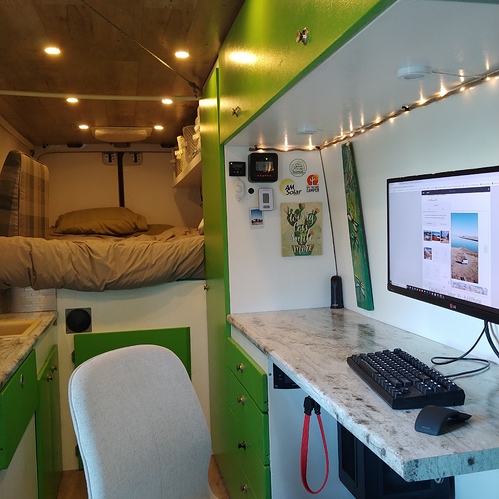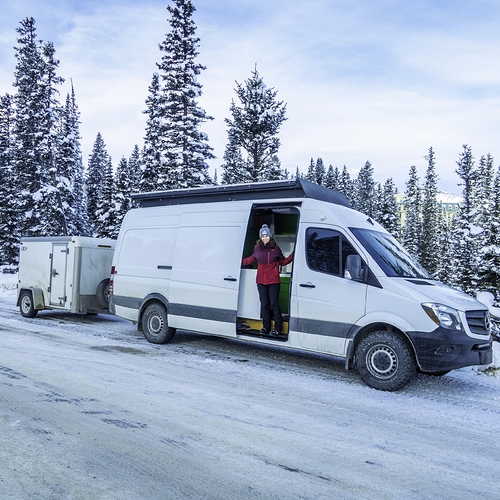As Canadian vanlifers, my husband and I are finishing our second winter in our rig. Thought I’d share some of the thing we planned in build phase and others we added afterwards. 

First thing first: we insulated, opted to add no windows for many reasons and have an ESPAR D2 installed and tapping the diesel tank of the vehicle (heater cannot drain tank below 1/4).
For insurance and personal reasons, we opted to add no fuel sources to our van build. We have a big electrical system and large battery bank as we do everything with electricity. Particularly in Canada (vs. US) winter solar gain is weak and days are short. We dramatically oversized our solar array to maximize production. We also fabricated a tilting rack to give an extra boost - we’ve this tilt literally double the amperage going into our batteries.
You can see in this photo a couple things worth explaining:
- Black square below the bed is a 12V computer fan pulling warm air from our living space under the bed to keep water and batteries warm in cold and frigid weather.
Our ESPAR is installed in the most popular spot, under the passenger seat. This means with our platform bed, warm air doesn’t reach the “garage” on its own. We force airflow with fans. In more recent van builds we have participated in, we install the heater under platform beds and run two ducts so both areas can have heat
- There’s a rope running diagonal across the ceiling. That’s our winter clothes line, which is positioned so we can turn our ESPAR heater vent towards the clothes hanging to dry them more quickly.
Dry heat sources are key for winter van/bus dwelling to fight condensation. Aside from dry heat, we also learned how beneficial it is to leave a roof vent opened to reduce/eliminate condensation/frost on the windshield.
Excellent tires make a big difference for poor road conditions. We towed a trailer this winter which housed the tools of my husband’s trade and our motorcycle for the weeks we took a break from Winter and went to Southern USA.
Winters are long. Days are short. It’s much more difficult to van dwell when you’re inside starting at 4pm when the sunsets. We’ve learned if you have the luxury to, taking a couple weeks break from winter’s intensity is very beneficial
Self Recovery/ Self Rescue: Carry snow chains, emergency shovel and max tracks so that you’re able to get yourself out of some sticky situations. It took us 12 months of travel but we got ourselves stuck. With the tools we had, it was 20 minutes to free ourselves.
Winter can be a blast. Keep snow and ice off your solar panels so you can stay charged.
**Any questions or other parts of winter vanlife you want to discuss? There’s so many great tips and tricks. We have been on the road for 13 months, 70,000km and have no plans to stop **
Happy adVANtures all! 





